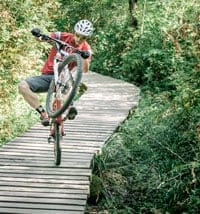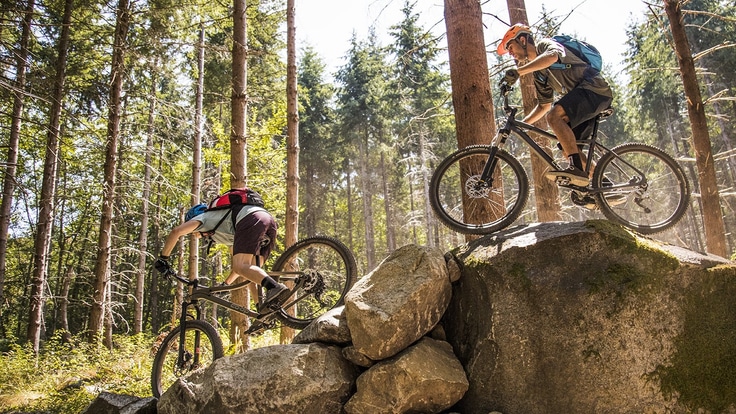All the elements of good technique come into play when climbing and descending hills on your mountain bike. Here are some techniques to help you get up and down the hill—not only intact, but also with style and grace.
Video: Riding Switchbacks
Climbing Hills on a Mountain Bike

Body position: Keep yourself loose on the bike, knees and elbows bent to help you remain responsive to the terrain. You want to let the bike take most of the brunt of the trail; shift your weight according to the changing terrain and features.
Where to look: Keep your eyes focused about 10 to 15 feet ahead of you on the trail so that you see the upcoming terrain changes and obstacles and make adjustments as needed. If you stare at a root or rock, chances are you're going to hit it. Instead, let your eyes flow ahead to better allow you to pick your line.
How to use your gears: Choosing the correct gear for the trail ahead of you can be challenging at first; just remember to look ahead and anticipate what you will encounter. If you're approaching a climb, shift to an easier gear as you hit the base of the climb. If you see a long downhill in front of you, shift to a harder gear. Rolling terrain is trickier, but with some practice you'll be shifting without even thinking about it.
Descending Hills on a Mountain Bike

Seat position for descending: Descending is where the fun begins and—for beginners—can be the most intimidating. First drop your seat, as you want a lot of clearance between your butt and the seat. This lets you respond to the variable terrain more easily, and helps you avoid getting bucked if you hit an unexpected bump and the seat comes slamming upward. Some bikes come with a "dropper post" which allows you to adjust the seat height on the fly via a remote lever on the handlebars.
Body position for descending: Keep your body low to the bike and position yourself far back so that your butt is practically suspended over the rear tire; make sure you're not sitting down and that your knees are bent. This lets the bike take the brunt of the terrain you encounter and also keeps your weight back, reducing your chance of going over the handlebars.
Unless you're pedaling, keep your feet and pedals parallel (the 3 and 9 o'clock "platform") so that pedals won't clip a rock or stump. Bend at the knees and elbows and relax your muscles so you can respond quickly to the changing trail conditions. Avoid gripping the handlebars too tightly.
How to brake: Braking should be consistent and controlled; most of your braking power comes from your front brake, but grabbing a handful of front brake will send you over the bars. Instead, lightly apply the brakes, and do so evenly on the front and back brakes. When approaching a turn, brake before you hit the turn, and then let your momentum carry you through.
Advancing Your Downhill Technique

Descending over boulders or drop-offs is an advanced technique and should be attempted only by experienced riders. If you're experienced and feeling confident, all the general guidelines apply, except with greater emphasis:
- Lean way back, with your butt behind your saddle.
- Keep your elbows bent and body low.
Rely on both brakes, but mostly on your rear brake, as you may need to release the front to provide more momentum.
Mountain Bike Etiquette
- Control your speed.
- Always yield right-of-way to cyclists traveling uphill (in singletrack, stop completely and lift the bike out of the trail).
- Always give a polite "on your left" whenever you pass another cyclist.
- Always give right of way to horses, hikers and runners (some trails have designated directions; consult the trail map).
